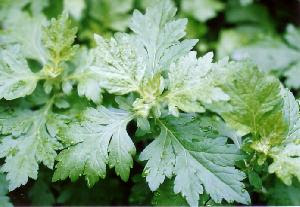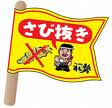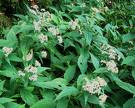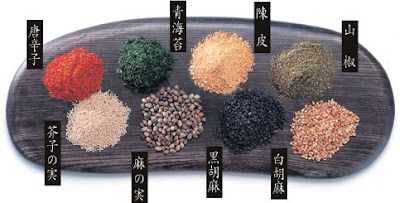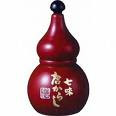::::::::::::::::::::::::::::::::::::::::::::::::::::::::::::::::::::::::::::::::::::::::::::::::::::
Specialities of the Season (shun no mono)
***** Location: Japan
***** Season: Topic
***** Category: Humanity
*****************************
Explanation
SHUN 旬 (しゅん) season, the best season for fresh food
shun no mono, 旬の物 specialities of the season, seasonal food
shun no aji, 旬の味 taste of the season
shun no mikaku 旬の味覚 seasonal delicacies
The most important part of washoku. It dates back to the time when no refrigerators were available.
shun is also the time when a vegetable (or something else) is "at its best" as a kigo for haiku, for example the ants in summer.
Most of the ingredients for cooking are also kigo.
See the World Kigo Database

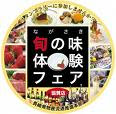
:::::::::::::::::::::::::::::::::::::::::::::::::::::::::::::::::::::::::::::::::::::::::::::::::::
Vegetables from a hothouse are found in the stores at any time of the year, they are never SHUN.
Vegetables of the season are full of the energy of the season, full of nutrition and vitamines and best for the human health. Vegetables produced on the free land have a lot more energy than those from the greenhouses.
In spring, the first sun givee new energy to the plants. Buds and first leaves of plants are eaten most often, like fuki no too or tara no me. (see mori no megumi)
In summer the energy circle is at it's hight. Most plants produce fruits and vegetables to eat, like cucumbers, eggplants or tomatoes.
In autumn, many grains and fruit or nuts from trees are harvested, like rice or persimmons. Natural energy tends to provide for the next generation already.
In winter, natural energy takes a rest. Now most of the roots of vegetables are eaten, like radish and turnips. They have a lot of fibers and are a great addition to the winterly nabe hodgepodge dishes.
Within each season, the FIRST hatsumono 初物 of something was also a great pleasure for the gourmets of Edo.
Ships would race to carry the first catch of bonitos, hatsugatsuo, hatsu gatsuo, to fetch a good price or bring it as a special present to the Shogun of Edo.
First rice or first tea of the season are also well known specialities.
Check the main
Washoku Saijiki
for more details about dishes with these seasonal ingredients.
:::::::::::::::::::::::::::::::::::::::::::::::::::::::::::::::::::::::::::::::::::::::::::::::::::::
Vegetables for Spring Cooking
asparagus, endomame beans, jagaimo potatoes, kyabetsu cabbage, nanohana mustard flowers, retasu lettuce and salads, tamanegi onions, udo Japanese spikenard and many more.
Frühlingsgemüse
Vegetables for Summer Cooking
 kyuuri cucumbers, mame-rui all kinds of beans, nasu eggplants, serori cellery, shishitoo hot peppers, shooga ginger, tomato, toomorokoshi corn, zucchini.
kyuuri cucumbers, mame-rui all kinds of beans, nasu eggplants, serori cellery, shishitoo hot peppers, shooga ginger, tomato, toomorokoshi corn, zucchini.hyakka 万葉(ひゃっか)"onethousand leaves" manba, takana from Kagawa
Sommergemüse
Vegetables for Autumn Cooking
kabu turnips, kabocha pumpkin, kinoko ki no ko mushrooms, ninjin carrots, rakkasei peanuts, piiman paprica, satoimo sato-imo yam, satsumaimo satsuma-imo sweet potatoes, shiitake mushrooms, tororo-imo yamspotatoes and many other mushrooms.
Herbstgemüse
Vegetables for Winter Cooking
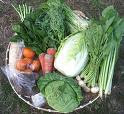 daikon radish, hakusai Chinese cabbage, hoorenso spinach, karifurawaa cauliflower and broccoli, komatsuna, kyoosai Kyoto vegetables, naganegi leek, renkon lotus roots, shungiku garland chrysanthemums, yamaimo yama-imo yam and others.
daikon radish, hakusai Chinese cabbage, hoorenso spinach, karifurawaa cauliflower and broccoli, komatsuna, kyoosai Kyoto vegetables, naganegi leek, renkon lotus roots, shungiku garland chrysanthemums, yamaimo yama-imo yam and others.Wintergemüse
:::::::::::::::::::::::::::::::::::::::::::::::::::::::::::::::::::::::::::::::::::::::::::::::::::::
YAM ... Dioscorea
is a genus of over 600 species of flowering plants in the family Dioscoreaceae, native throughout the tropical and warm temperate regions of the world. The vast majority of the species are tropical, with only a few species extending into temperate climates.
© More in the WIKIPEDIA !
yamaimo, yama imo, yama-imo 山芋
Dioscorea japonica
Japanese yam
. . . CLICK here for Photos !
yama no imo ヤマノイモ(山の芋)"root from the mountain"
There used to be about 13 different wild ones in the mountains of Japan.
They came to Japan via China as a cultivated plant. There are no wild ones.
They are the most popular, grown all year as "ichinen imo" 一年芋.
Also called "tokkuri imo" トックリイモ(徳利芋).
Jinenjo 自然薯(学名: Dioscorea japonica Thunb.)
In Okayama prefecture, Kibi Chuo Town, mochi are prepared with these roots.
Some special forms of yamaimo:
gingko leaf root, ichoo imo イチョウイモ(銀杏芋)because of the form.

These are also called "hands folded in Buddhist prayer" busshoo imo ブッショウイモ(仏掌芋).
In the Kanto area, they are called "Yamato imo" ヤマトイモ(大和芋).
Varieties are "tsukuneimo" ツクネイモ(つくね芋), "Tanba no imo" 丹波山の芋, Iseimo 伊勢芋.
nagaimo... 長芋(Dioscorea batatas Decne)
Yamaimo are used to make the slimy tororo, they are therefore also called
tororoimo, tororo imo とろろ芋、トロロ芋.
(Dioscorea opposita)
. Tororo jiru とろろ汁 (とろろじる)grated yam with miso bean paste soup
and other autumn dishes
tokoro ところ【野老】 Japanese yam
Dioscorea tokoro
. . . CLICK here for Photos !
The roots of this plant are only edible after getting rid of the bitterness. It is eaten in some areas by the poor farmers.
more KIGO with yama-imo, Japanese YAM
propagule 零余子 (むかご) mukago
of the yam
Jamswurzel, Yamswurzel
Matsuo Basho and haiku about TOKORO yam
. Yam dreaming . Australia
:::::::::::::::::::::::::::::::::::::::::::::::::::::::::::::::::::::::::::::::::::::::::::::::::::::
quote
The sweet potato (Ipomoea batatas)
has traditionally been referred to as a "yam" in parts of the southern United States and Canada even though it is not part of the Dioscoreaceae family.
The word yam comes from Portuguese inhame or Spanish ñame, which both ultimately derive from the Wolof word nyam, meaning "to sample" or "taste"; in other African languages it can also mean "to eat", e.g. yamyam and nyama in Hausa.
The majority of the vegetable is composed of a much softer substance known as the "meat". This substance ranges in color from white or yellow to purple or pink in ripe yams.
Konnyaku belongs here too.
© More in the WIKIPEDIA !
............................................
WASHOKU
satoimo, sato imo 里芋 taro
Colocasia esculenta
taro imo タロ芋
In German we have
Taro-Kartoffel sato-imo
Jamswurzel (Duden spelling), Yamswurzel, yama-imo
Süßkartoffel ist Satsumaimo.
:::::::::::::::::::::::::::::::::::::::::::::::::::::::::::::::::::::::::::::::::::::::::::::::::::::
kabocha
the name derived from the Portugese, which introduced this vegetagle from Cambodia (カンボジア kambojia ... kaboja). The Chinese characters imply "a gourd that came from the south (Nagasaki)" 南瓜.
. WASHOKU
kabocha 南瓜 (かぼちゃ) pumpkin, squash
:::::::::::::::::::::::::::::::::::::::::::::::::::::::::::::::::::::::::::::::::::::::::::::::::::::
Cauliflower and Broccoli
Cauliflower, Brassica oleracea var. botrytis
Japanese name for cauliflower is hanayasai ハナヤサイ(花椰菜) flower vegetable or hanakanran ハナカンラン(花甘藍)flower cabbage, literally the German "Blumen Kohl". Or
花梛菜(はなはぼたん)hana habotan "Blumen-Pfingstrose" flower-peony. The second Chinese character 梛 is NAGI, Podocarpus nagi, Japanische Steineibe.
Broccoli, Brassica oleracea var. italica
Japanese name for broccoli: midori hanayasai ミドリハナヤサイ(緑花野菜)
green flower vegetable or flower vegetable hanayassai メハナヤサイ(芽花野菜)
Grown in Yamaguchi prefecture, a mix between broccoli and the chinese vegetable saishin 薄葉細辛Asiasarum sieboldii is called hanakkori はなっこりー and is sold since 2003.
A mixture of broccoli and cauliflower is called romanesuko ( ロマネスコromanesque) in Europe, but in Japan it is karikkorii カリッコリー.
Main growing areas are Saitama, Aichi, Hokkaido.
Both vegetables came to Jaan after the Meiji restauration in 1868, not only as a vegetable but as a flower to enjoy in the garden. After WWII it became more widespread as food in Japan, together with a wider influnece of Western food.
burokkori ブロッコリ broccoli
komohcihana yasai 子持花椰菜(こもちはなやさい)"vegetable with a flower that has children"
kigo for all winter
Blumenkohl und Brokkoli

:::::::::::::::::::::::::::::::::::::::::::::::::::::::::::::::::::::::::::::::::::::::::::::::::::::
WKD : Radish (daikon) Rettich
(Raphanus sativus L.)
nezumi daikon ねずみだいこん/ ねずみ大根 "rat radish, mouse radish"
from Shimabara. It has a very strong taste. They are quite small and thick.
Similar to Momoyama daikon.
Since 1695, this radish was mentioned as grown by farmers in a district called NEZUMI, Rat in Shinshuu and eaten with buckwheat noodles. 信州埴科郡坂城町中之条の鼠地区
. . . CLICK here for Photos !
hatsuka daikon 二十日大根 ( はつかだいこん) "20 days old radish"
a fast-growing round and small radish. Comes in the colors red, yellow, purple and white. Originally from Europa, indroduced to Japan in the Meiji period. also called
radisshu ラディッシュ
. . . CLICK here for Photos !
Shinshu-ji-daikon, Maesaka-daikon, Oyadakarami-daikon, Akaguchi-daikon, Daimon-daikon, Tatara-daikon, Togakusi-daikon, Wattera-daiokn わってら大根, Haibara-daikon, Maki-daikon, Kirehamatumoto-ji-daikon and more varieties.
Ueno-daikon 上野大根
Edo Yasai, Edo dentoo yasai 江戸伝統野菜
Traditional vegetables of Edo
. WASHOKU
Dentoo yasai 伝統野菜 Traditional Japanese Vegetables
:::::::::::::::::::::::::::::::::::::::::::::::::::::::::::::::::::::::::::::::::::::::::::::::::::::
More vegetable kigo for All Winter
hakusai 白菜 (はくさい) chinese cabbage
ninjin 人参 (にんじん) carrots
early winter
kanchiku no ko 寒竹の子 (かんちくのこ)
babmoo shoots in the cold
... 寒筍(かんたけのこ)
TBA
:::::::::::::::::::::::::::::::::::::::::::::::::::::::::::::::::::::::::::::::::::::::::::::::::::::
shishitoo ししとう【獅子唐】
small sweet green pepper
shishitoogarashi 獅子唐辛子
best in summer
. . . CLICK here for Photos !
Fushimi toogarashi 伏見トウガラシ
Manganji toogarashi 万願寺トウガラシ
from Kyoto、both are rather sweet
taka no tsume 鷹の爪 "tallon of a hawk"
Evodiopanax innovans
. . . CLICK here for Photos !
WASHOKU
Togarashi 唐辛子 red hot pepper
:::::::::::::::::::::::::::::::::::::::::::::::::::::::::::::::::::::::::::::::::::::::::::::::::::::
kinpira キンピラ simmered root vegetables
Niigata
*****************************
Worldwide use
jahreszeitliche Spezialitäten
Zutaten aus der Jahreszeit
*****************************
Things found on the way
*****************************
HAIKU
苗代風吹いて鰈の旬となる
yawashiro kaze fuite karei no shun to naru
wind blows
over the rice seeldings ...
season for flounders
Ninomiya Miyo 二宮美代
:::::::::::::::::::::::::::::::::::::::::::::::::::::::::::::::::::::::::::::::::::::::::::::::::::::

人参を並べておけば分かるなり
ninjin o narabete okeba wakaru nari
when I arrange
the carrots side by side
I understand
Tokita Tomoya 鴇田智哉 (1969 - )
:::::::::::::::::::::::::::::::::::::::::::::::::::::::::::::::::::::::::::::::::::::::::::::::::::::
山冷のどんぞこ薬喰の旬
yamabie no donzoku kusuri gui no shun
in the middle of
cold winter mountains ...
season for medicinal food
Fujita Minoru 藤田美乗
MORE
source : 俳句例句データベース Japanese haiku about SHUN
kusurigui, "eating medicine" kigo for all winter
*****************************
Related words
kulinarisch Augenschmauß
***** WASHOKU : INGREDIENTS
Daikon ... Radishes used in Temple Ceremonies
Kyooyasai, kyoyasai, kyosai 京野菜 / 京菜 Vegetables from Kyoto.
Gemüse aus Kyoto, Kyoto-Gemüse
. Takana 高菜 mustard greens .
***** WASHOKU :
YASAI . Vegetable Saijiki
[ . BACK to WORLDKIGO TOP . ]
:::::::::::::::::::::::::::::::::::::::::::::::::::::::::::::::::::::::::::::::::::::::::::::::::::::
